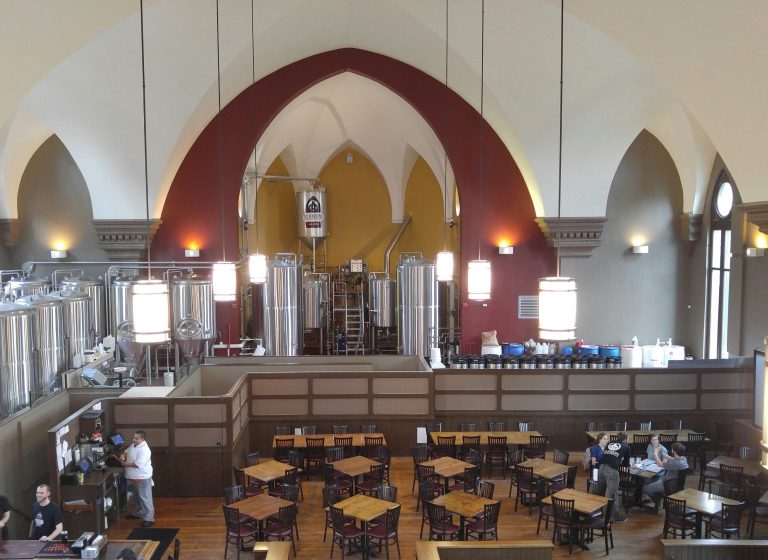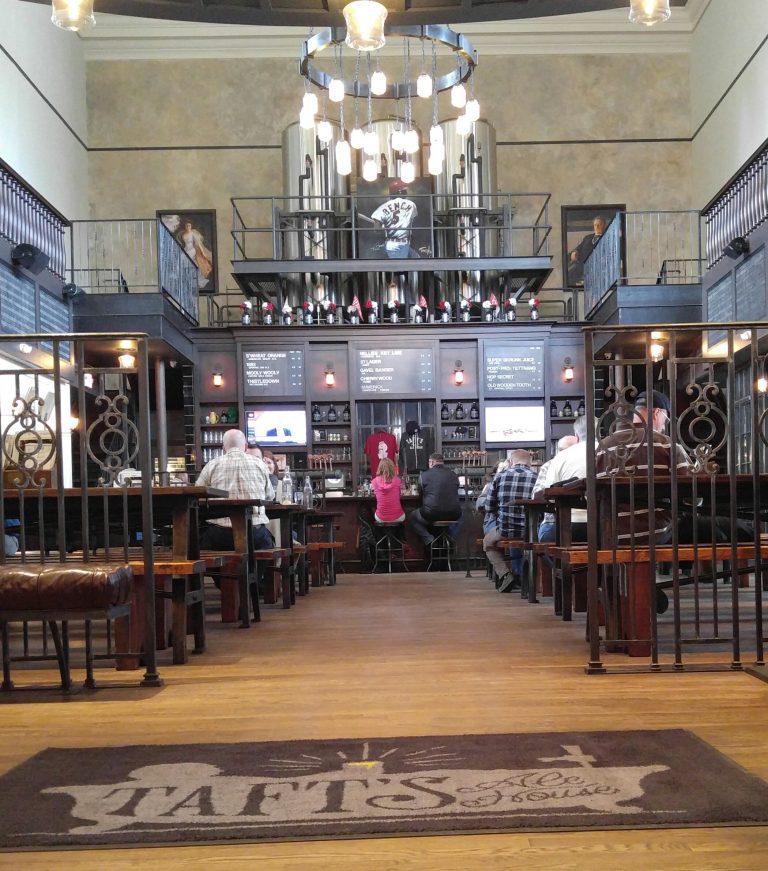Livin' On a Prayer
All photos by Phil Galewitz.
I visited Indianapolis and Cincinnati in early April and spent a couple days in several churches— admiring the 19th century architecture, learning about their history, but most of all, enjoying the beer.
Yes, former churches are coming back to life again as breweries and brewpubs, helping revitalize neighborhoods and quenching communities’ growing thirst for craft beer. Nationally, there’s about a dozen such reformations, from Pennsylvania to Oregon.
The Church Brew Works in Pittsburgh pioneered the trend of beer-making in a renovated house of prayer when it opened in a 112-year old Roman Catholic Church in 1996. The trend makes sense as churches for centuries served as meeting places and that’s what breweries have become in the 21st century.
Saint Joseph's
St. Joseph’s Brewery and Public House near downtown Indianapolis opened in 2014 in a church built in 1880. Walking up to the grand red brick building with a cross still affixed to one of its steeples, its easy to recall this as a place of worship, even though St. Joseph held its last mass on June 26, 1949. Sitting in one of the remaining pews on the second floor overlooking the massive space with its large windows and crown molding throughout carved in the shape of a bishop’s hat, you can really get that church feel. Although now, the stainless steel fermentation tanks now sit on the stage where priests used to give sermons and empty kegs are lined up below them like parishioners waiting to take communion.
After the last mass, the church building, still owned by the Archdiocese of Indianapolis, was converted to the Catholic Community Center, used as a meeting hall and auditorium for several organizations including the Catholic Charities Bureau and Catholic Youth Organization. The Archdiocese sold the building to a private investor in 1986 where it stood empty for decades when a local restaurant group bought the property to convert it to a restaurant and brewery as part of a neighborhood rejuvenation.
Today, St. Joseph’s remains popular with different church groups in Indianapolis — not as place to pray but as an outing for family and friends. The large wooden bar than lines one side of the building was made from some of the original wood found on site. St. Joseph’s beers keep the church theme with names like Sanctuary Saison, Benevolent Belgian Blonde Ale and Confessional Ale. The beers are made on a 15 bbl. system that sits so close to the tables you can see your reflection in the metal.
There’s a small stained glass window above the two front doors to the brewery with picture of the bar over a field of grain. Over the doors is a Latin inscription that is loosely translated into English with the words: “Bless O’ Lord, this creature beer.”
The bartender said the historic nature of the building has helped the brewery attain a following from both locals and tourists. “We get a lot of folks saying, “oh my god, I’m in a church drinking a beer,” she said.
A flight of four 4-ounce beers costs just $7, making it easy to try many of the 10 beers on tap. The wide ranging menu of upscale brewpub food also helps whet your pallet. The artisanal charcuterie and cheese plate for $12 included delicious house made beef jerky along with salami, cheeses fig jam and toast. Burgers, steaks, meatloaf, salads, seafood and a German sausage plate round out the menu.
Taft's Ale House
About 100 miles from Indianapolis, Cincinnati is home to two churches turned into breweries—both having opened since 2015.
Just north of downtown, is Taft’s Ale House. Walking up the grand staircase into Taft’s with its large chandelier, soaring ceiling and three large cylindrical brewing tanks which tower behind the bar like pipes from a cathedral organ, it almost feels like people would come praying for beer. With baseball season opening the week of my visit, a large picture of Hall of Famer Johnny Bench is laying just in front of the tanks, an indicator that while this once heavily German immigrant loves beer, baseball and the Reds rule over everything else.
Patrick Woods, a brewer at Taft’s Ale House, says its great to work in such a historic building that was built as St. Paul’s Evangelical Church in 1851. “Its cool, but this place wasn’t originally built to make beer,” he said.
Following the decline of inner city, the church was sold in 1948 and the building was vacant after 1974. In 2011, the city worked with local development corporation to save the building from demolition and find a commercial tenet for the space.
In 2014, a Midwest venture capitalist and a New York restauranteur got together to turn it into a brewery and restaurant. It re-opened as Taft’s Ale House in April 2016.
Taft’s is in the middle of the city’s Over-the-Rhine neighborhood, which is the nation’s largest historic district. Lagering tunnels run for hundreds of yards under the neighborhood - places where breweries in the 19th century stored beer before refrigeration and a highlight of underground Cincinnati tours.
Taft’s Ale House pays homage to William Howard Taft, the 27th president of the United States and native of Cincinnati. The bar napkins include iconic drawing of Taft in a bathtub. The tap handles at the bar are all in the shape of a judge’s gavel. Taft served on the Supreme Court after his one term in the White House. There’s a large photo of President Taft next to the fermentation tank and numerous historical photos of Taft and his family scattered on the brewpub’s three floors.
Taft’s specialty is their tri-tip steak, with a juicy French dip that comes in an artisan role filled with caramelized onions. There’s a rotating set of beers though my favorite had to be Mooly Wooly, a 4.3% ABV coffee milk stout that was just right combination of chocolate and coffee to enjoy at lunch. The Maverick, a chocolate porter was also quite smooth tasting with its cocoa nibs from a local chocolatier. Their top selling beer is Nellies Key Lime, an ale made with key lime juice that pays homage to Taft’s wife Nellie who loved key lime pie. The downstairs bar, also called Nellies, serves craft cocktails in a fashionable setting with dark paneled walls.
Urban Artifact
About 10 miles north of downtown Cincinnati, you’ll find Urban Artifact Brewing in the basement of the former St. Pius X church. From the road, its hard to see there’s even a brewery in the grand edifice. The rustic taproom is housed in the lower level of historic church while the 30-barrel brewhouse is housed in the old gymnasium just behind the church.
Specializing in tart and sour beers, all of Urban Artifact’s brews are “wild,” meaning they’re made with locally caught wild yeast and bacteria, or mixed cultures of both. The beers, some bottled but most on draft, offer a wide range of delicious and funky flavors.
Their flagships run the gamut of sourness, offering something for everyone and include Finn, a Berliner pale ale, Cauldron, a dry Irish stout and Phrenology, a wild IPA. Urban Artifact sell beers in the city and offers a selection. One of the most popular beers in April was Squeezebox, a 7.1% ABV sour ale that’s made with fresh strawberries. The brewery works to educate their customers on sour beers, understanding that some people need to be introduced to their beer more gently.
Scotty Hunter, co-founder and chief of strategic development for Urban Artifact, said the church closed in 2007 and was the perfect location when he was looking to switch careers from working as a sales rep to making beer full time. They decided to focus on sour beers to help the brewery stand out in an ever growing crowded field of craft beers.
The church’s sanctuary space has been used for special events since 1876, and the brewery still rents it for such happenings including weddings. Hunter said he and the other two owners tried to reuse as much materials from the church as they could in creating the tap room. Some of the tables, for example, use leftover pipe. Maple slabs from the former gym floor behind the bar serve as a board that displays the beers on tap, and were also used to create flight holders. Some 1930s-era lamps found in church garage now hang over the bar.
To educate customers about the brewery's tart and wild ales, Urban Artifact lists the pH of each in its tap room. (Tartness increases as the number gets lower.) The rustic venue plays music most nights, where local bands perform on the tucked away stage near the taproom.
Amen.






